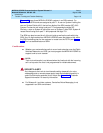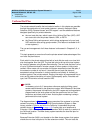
MERLIN LEGEND Communications System Release 6.1
Network Reference
555-661-150
Issue 1
August 1998
Introduction
Page 1-13Tandem Trunking and Tandem Switching
1
NOTE:
In the following example, the PRI tandem trunks are implemented on T1
circuits provisioned for bipolar 8 zero substitution (B8ZS) line code.
Figure 1–4. Series Configuration: Four Systems
From a planning perspective, consider the following points about the series
configuration illustrated in Figure 1–4
.
■ System D is linked to the private network by tie lines (a total of 8), so users
at MLX display telephones on System D cannot see the name and/or
number of a caller who reaches them from another system in the private
network.
■ To ensure proper transmission quality, the path of a private network call
should include no more than two
spans
of analog tie trunks. The private
network in Figure 1–4
includes one such span, between Systems C and D.
■ When an outside dial-plan routed PRI call with ANI arrives on System A or
B, ANI calling party information travels to a destination extension on
systems connected by PRI tandem trunks (A, B, or C) but not across tie
tandem trunks (System D). System D users can receive this information
only from their PRI to the PSTN.
■ System D is located in close geographic proximity to System C. This allows
System D to use the PSTN for 2B video calls with System C at up to 128
kbps without incurring high toll costs. However, because of the tie
connections, intersystem video and intersystem high-speed data calls are
not supported to and from System D.
PSTN
Tie / 4
Tie / 4
P R I / 2 4
P R I / 2 4
P R I / 2 4 P R I / 2 4 B R I (1 6 ) P R I / 2 4
48 lines
Intersystem
and outside
up to 128-kbps
2B data
72 lines
Intersystem
and outside
up to 128-kbps
2B data
48 lines
Intersystem
128-kbps 2B
d a ta ; o u ts id e
up to 128-kbps
2B data
32 lines
Outside
128-kbps up to
2B data
ML A ML B
NY IL
ML C
CA CA
ML D
Centralized VM S/AA
VMS


















